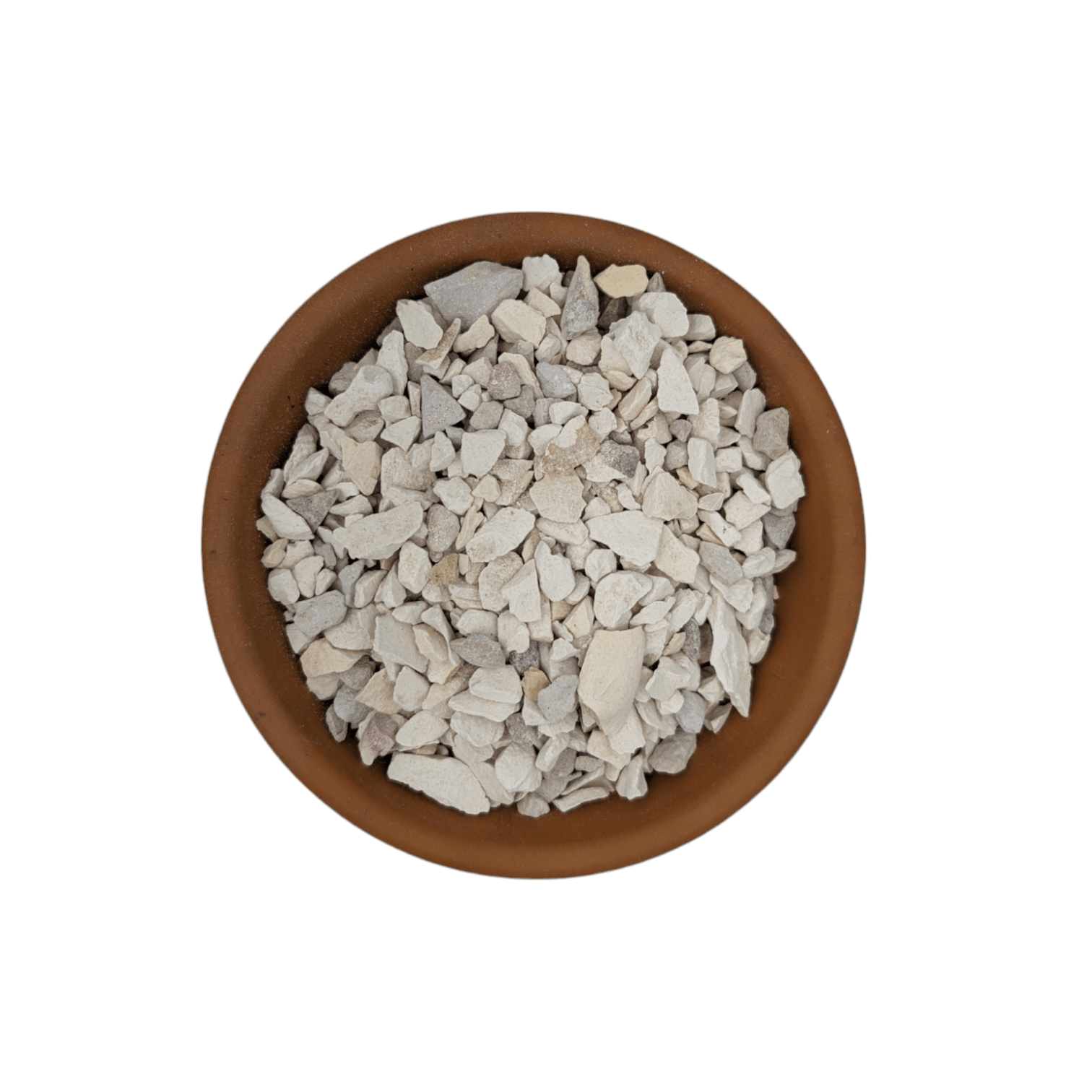Diatomite 3–8mm is a highly effective and naturally formed soil amendment made from fossilized remains of ancient marine plants.
These lightweight granules are celebrated for their exceptional moisture retention, porosity, and long-term durability in soil, making them ideal for growers seeking a dependable, low-maintenance medium.
Used widely across bonsai, succulent, cactus, and no-till gardening communities, diatomite's unique structure promotes optimal root oxygenation and thermal regulation. It also slowly releases bioavailable silica, contributing to stronger plant structures and improved resistance to stress.
Features
-
100% natural diatomaceous earth in 3–8mm granules
-
Excellent moisture retention with high porosity
-
Lightweight and easy to mix into custom soil blends
-
Rich in bioavailable silica to strengthen plant cell walls
-
Does not compact or degrade quickly in soil
-
Helps buffer temperatures in containers for even root zone conditions
-
Ideal for bonsai, cactus, succulents, and no-till gardening systems
Why You Should Buy
Diatomite is a smart choice for growers looking for a cost-effective, high-performance soil additive that enhances both moisture regulation and soil aeration. Its slow breakdown rate makes it perfect for long-term use, and its lightweight nature also reduces shipping costs—especially valuable for bulk buyers. With the added benefit of bioavailable silica, your plants gain structural resilience, improved nutrient uptake, and a stable growing medium that supports healthy development in even the most sensitive species.
FAQs
What exactly is Diatomite 3–8mm?
It’s natural, lightweight, super-porous granules made from fossilised algae (diatoms). In the 3–8mm grade, the pieces act like tiny sponges and air pockets—boosting drainage while holding a little moisture so roots can breathe.
How is Diatomite different from diatomaceous earth powder?
Same raw material, different job. Powder (micronised) is for dusting pests and filtration. These 3–8mm chunks are for soil structure, drainage, aeration and gentle moisture buffering.
Why pick the 3–8mm size over 10–15mm?
Smaller grade = more contact with the mix and smoother moisture distribution. Great for houseplants, succulents, cacti, aroids, orchids, bonsai, and as a gnat-resistant top-dress—especially in small to medium pots where 10–15mm can feel too chunky.
Will Diatomite help with overwatering and root rot?
Yes. It breaks up heavy media, reduces waterlogging and keeps oxygen around roots. You still need pots with drainage and sensible watering, but it’s very forgiving.
Does Diatomite hold water or just drain fast?
Both. The pores soak up some water and nutrients, then release them slowly—reducing the “soggy today, bone-dry tomorrow” swings.
Is freshwater diatomite safe for plants?
Yep—horticultural grade. It’s inert, low-salt, and plant-safe.
Will Diatomite change my soil pH?
It’s generally neutral to slightly alkaline. In most mixes the shift is negligible. If you’re chasing acidic media, balance with your other ingredients.
Does Diatomite feed plants?
Not a fertiliser. It can contribute plant-available silica over time (tougher stems, better stress tolerance), but you’ll still run your normal feeding program.
How much should I mix into potting soil?
Start at 20–30% by volume for general houseplants. Go 40–60% for succulents/cacti/bonsai, or if your environment is humid and pots dry slowly. Adjust after you see your new dry-down time.
Can I use Diatomite as a top-dress to fight fungus gnats?
Yes. Rinse, then apply a 1–2 cm layer. It dries quicker at the surface, discouraging egg-laying. Pair with sticky traps/BTi if gnats are established.
Good for orchids and aroids?
Totally. For orchids, blend with bark/charcoal to tune moisture. For aroids, mix with bark, perlite and quality composted base to keep it airy but not parched.
What about bonsai?
Popular in bonsai mixes (often 30–60%). It builds fine feeder roots, stays open for years, and doesn’t float.
Is Diatomite 3–8mm suitable for small pots and seedlings?
Yes—this is the go-to size for 90–200 mm pots and trays. For very tiny plugs/seedlings, you might want an even finer grade blended in, but 3–8mm works in most small containers.
Can I use Diatomite for semi-hydro / passive hydro?
You can, but it wicks differently to LECA. If experimenting, start with a 50/50 blend with LECA or run shallower reservoirs and watch EC/moisture.
Can I use a bottom drainage layer?
You can add a 1–2 cm base layer in larger pots to prevent soggy zones. It’s not a substitute for drainage holes.
Do I need to rinse Diatomite before use?
Strongly recommended. A quick hose/colander rinse removes fines so your mix stays extra-airy.
Will Diatomite float like perlite?
No. It’s denser and stays put during watering.
Does Diatomite break down or compact over time?
Very slowly. It keeps structure for years, unlike bark/peat that slump and compact.
Is Diatomite reusable?
Often, yes. After repotting, wash and sieve, then sun-dry (or low-oven dry) before re-using.
How does Diatomite compare to perlite?
Perlite is ultra-light and can float/blow away; diatomite is heavier, stays mixed, and offers better moisture buffering. Perlite is cheaper per litre; diatomite lasts longer structurally.
How does Diatomite compare to pumice or scoria?
All improve aeration. Diatomite holds and releases moisture a bit more evenly than scoria, and is similar to pumice for structure with the bonus of silica. Many growers blend them.
Will Diatomite help in heatwaves?
Yes. The pores buffer temperature swings around roots and cut the “bake and wilt” effect, especially in black plastic pots or full sun.
Any plants that don’t love Diatomite?
Ultra acid-loving species in tiny pots (some carnivores, certain ericaceous plants) may prefer finer, more acidic media. Most ornamentals and edibles do great.
Can I use Diatomite in raised beds, or just pots?
Best impact is in containers. In beds you’d need a lot to notice a difference—use compost/mulch for bulk improvement and save diatomite for pots/planters.
Will Diatomite clog drainage holes?
Not at this size. If your mix is heavy on fines, add a mesh over holes or a thin base layer to be safe.
Does Diatomite dust? Is it safe to handle?
There can be some fines from transport. Rinse first, and avoid breathing dust—basic eye/mask protection if you’re sensitive. In the pot it’s inert and safe around pets/kids (don’t let anyone eat it).
How will my watering change?
Usually a bit more frequent than peat-heavy soils, but less yo-yoing. Watch weight, finger test, or use a moisture meter for the first couple of weeks and adjust.
What sizes do you stock?
2 L, 5 L and 10 L bags.
Any tips for first-timers?
Rinse, start at ~30% of your mix, and track how fast it dries for two water cycles. Use a 1–2 cm top-dress to cut gnats and surface crusting. Keep fertilising—this is structure, not food.
Can I mix Diatomite with coco/peat/bark?
Absolutely. Easy starter blend: 1 part base mix (quality potting soil or coco), 1 part diatomite, 1 part chunky add-in (bark/perlite/pumice). Tweak to your climate and pot size.
Is Diatomite compatible with fabric/air-pots?
Yes—great combo for oxygen and fast, even dry-down without creating hydrophobic pockets.
Does Diatomite affect EC or nutrient availability?
It’s inert, so it won’t spike EC. It can adsorb/release a bit of nutrient solution like a buffer, which smooths peaks and troughs—just monitor as normal.
Can I use Diatomite in aquariums or filters?
This product is sold for horticulture. Don’t use it in aquariums or as a pool/filter medium.
How do I store Diatomite?
Dry and covered. If it gets muddy, just rinse and dry—it won’t “go off.”
What’s the best way to transition a plant into a diatomite-heavy mix?
At repot, shake off loose old media, prune dead roots, and pot into your new blend. Water through once to settle (don’t over-compact), then resume normal care and feeding.


